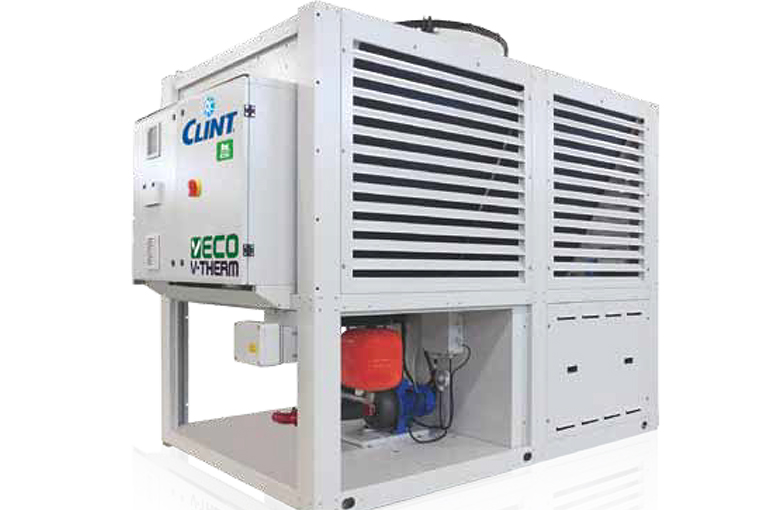19 August 2025
|
Darryl Smith, Managing Director of AUK Nationwide Heating and Cooling Distribution, shares his perspective on one of the industry’s most talked-about decarbonisation solutions: R290 in heat pump chillers.

The HVAC market is shifting fast as the drive for low-carbon solutions intensifies. A key enabler of this change is the adoption of ultra-low GWP refrigerants, and R290 (propane) stands out as one of the most promising. For commercial and industrial projects, R290-based heat pump chillers are bringing high-temperature capability, efficiency and service simplicity to the forefront.
Among these, Clint’s ECO-V-THERM range exemplifies how far these products have come, not just in environmental credentials, but also in technical flexibility and application suitability.
R290 is a natural hydrocarbon refrigerant with a Global Warming Potential (GWP) of just 3, significantly lower than commonly used refrigerants like R32 (GWP 675) and R454B (GWP 466). Like these synthetic options, R290 has no ozone depletion potential, and it supports long-term decarbonisation through both direct and indirect emission reductions over the lifecycle of a heat pump chiller system. Its excellent thermodynamic properties make it a viable long-term solution in both comfort and process cooling sectors.
Small charge, big benefit
R290’s thermodynamic efficiency allows systems to operate with significantly lower refrigerant charge volumes compared to synthetic refrigerants like R32 or R454B. In some commercial systems, the refrigerant charge can be as much as five to six times lower than an equivalent output system using R32, resulting in a package that reduces the refrigerant handling burden for engineers while providing high efficiency and environmental peace of mind for end users.
For example, a 164kW R290 Clint heat pump with two circuits requires just 7.5kg of refrigerant per circuit, totalling around 15kg overall. In contrast, an R452B-based system of the same capacity could require over 34kg, and an R454B system would also typically demand a higher charge volume due to its lower volumetric cooling capacity.

This reduction in refrigerant mass brings multiple benefits:
- Lower cost and environmental risk in the event of a leak
- Faster, simpler commissioning and servicing
- Easier compliance with safety standards and flammability classifications
Lower pressure, longer life
R290 operates at significantly lower pressures than many HFC or HFO alternatives. Even some of the newer low-GWP refrigerants like R454B (a blend of R32 and HFO-1234yf with a GWP around 466) or R513A (a blend of R134a and HFO-1234yf) still operate at higher condensing pressures than R290.
Where R290 typically operates in the range of 8–10bar, R32 systems can reach 15–17bar, and R410A can exceed 20bar. These higher pressures can place greater mechanical stress on system components, including compressors and pipework.
By contrast, R290’s low-pressure profile helps extend equipment life, reduce the risk of fatigue-related failures and support long-term reliability. That’s a key concern for facilities where equipment access is restricted or downtime is costly. It also supports longer service intervals and better total cost of ownership.
Flammability and regulation
R290 is rated as an A3 refrigerant: non-toxic but highly flammable. That classification understandably raises concerns but with modern system design, these risks are increasingly well managed.
One key factor is that heat pump chillers like ECO-V-THERM contain all of their refrigerant charge outdoors, within a factory-sealed unit. Unlike VRF or split air conditioning systems where refrigerant pipes run through occupied indoor spaces, chillers keep the refrigerant circuit entirely separate from the building interior. This not only reduces the risk of leaks into enclosed rooms, but also simplifies compliance with building codes and flammable refrigerant safety guidelines.
As a result, R290-based heat pump chillers are re-emerging as a popular choice among consultants and contractors, especially in settings where building control officers or fire regulations restrict the use of higher GWP or flammable refrigerants indoors. Their ability to decarbonise heating and cooling, while keeping refrigerant handling external is helping them gain traction as a compliant, future-proof alternative to VRF.
Installer-friendly and retrofit-ready
From the installer’s perspective, R290 heat pump chillers deliver a rare combination of technical performance and practical serviceability, especially in retrofit scenarios.
We’re seeing growing demand for high-temperature heat pumps that avoid the need for expensive and disruptive emitter replacements. In public-sector projects such as schools, healthcare sites, and social housing retrofit budgets are tight, and works often need to be completed with minimal interruption. Being able to retain existing radiators or terminal units reduces on-site complexity and shortens installation time. It also avoids the headaches of rebalancing pipework or adapting control strategies, factors that can delay projects or inflate costs.
From a maintenance standpoint, ECO-V-THERM units offer easy access, modular construction, and well-established components such as scroll compressors and EC fans.
For consultants and contractors, that adds up to a flexible, futureproof solution, one that balances low-carbon performance with the real-world demands of compliance, cost control and continued service delivery.
R290 might once have been viewed as niche or specialist, but the reality today is different. Thanks to manufacturers like Clint refining the technology into safe, standardised and high-performing equipment, it’s now a mature solution that addresses the core needs of designers and installers.
With performance to rival synthetic refrigerants, minimal GWP, and clear retrofit advantages, R290 in heat pump chillers like ECO-V-THERM is not just a responsible option, it’s a smart one.








